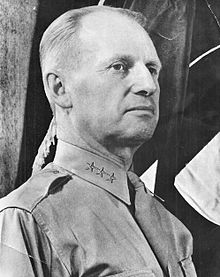
Back ليزلي جيه ماكنير Arabic Lesley J. McNair Danish Lesley J. McNair German Lesley McNair French Lesley James McNair Italian Lesley McNair Polish Макнейр, Лесли Russian Леслі Макнейр Ukrainian 萊斯利·麥克奈爾 Chinese
Lesley James McNair (May 25, 1883 – July 25, 1944) was a senior United States Army officer who served during World War I and World War II. He attained the rank of lieutenant general during his life; he was killed in action during World War II, and received a posthumous promotion to general.
A Minnesota native and 1904 graduate of the United States Military Academy, McNair was a Field Artillery officer with a background in the Ordnance Department. A veteran of the Veracruz occupation and Pancho Villa Expedition, during World War I he served as assistant chief of staff for training with the 1st Division, and then chief of artillery training on the staff at the American Expeditionary Forces headquarters. His outstanding performance resulted in his promotion to temporary brigadier general; at age 35, he was the Army's second-youngest general officer.
McNair's experience of more than 30 years with equipment and weapons design and testing, his administrative skills, and his success in the areas of military education and training led to his World War II assignment as commander of Army Ground Forces. In this position, McNair became the "unsung architect of the U.S. Army",[1] and played a leading role in the organizational design, equipping, and training of Army units in the United States before they departed for overseas combat. While historians continue to debate some of McNair's decisions and actions, including the individual replacement system for killed and wounded soldiers, and a controversy over the use of tanks or tank destroyers as anti-tank weapons, his concentration on advanced officer education, innovative weapons systems, improved doctrine, realistic combat training, and development of combined arms tactics enabled the Army to modernize and perform successfully on the World War II battlefield, where the mobility of mechanized forces replaced the static defenses of World War I as the primary tactical consideration.
He was killed by friendly fire while in France to act as commander of the fictitious First United States Army Group, part of the Operation Quicksilver deception that masked the actual landing sites for the Invasion of Normandy. During Operation Cobra, an Eighth Air Force bomb landed in his foxhole near Saint-Lô when the Army attempted to use heavy bombers for close air support of infantry operations as part of the Battle of Normandy.
© MMXXIII Rich X Search. We shall prevail. All rights reserved. Rich X Search
